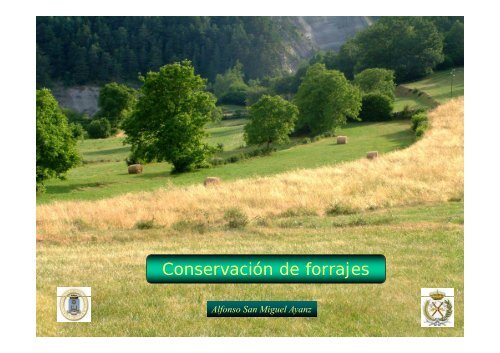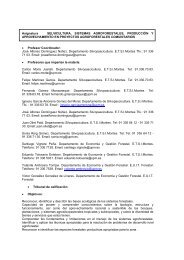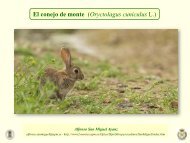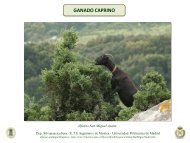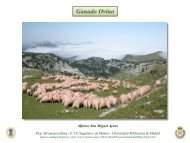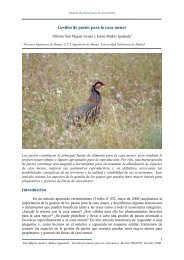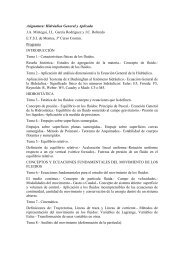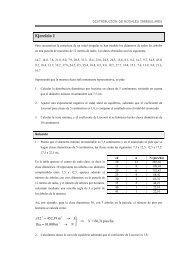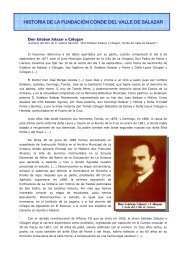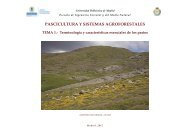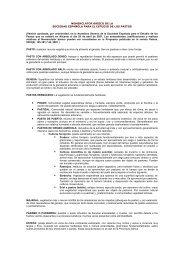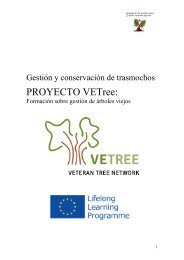Conservación de forrajes
Conservación de forrajes
Conservación de forrajes
You also want an ePaper? Increase the reach of your titles
YUMPU automatically turns print PDFs into web optimized ePapers that Google loves.
<strong>Conservación</strong> <strong>de</strong> <strong>forrajes</strong><br />
Alfonso San Miguel Ayanz
CONSERVACIÓN DE LOS FORRAJES<br />
¿ POR QUÉ SE CONSERVAN LOS FORRAJES ?<br />
• Mala distribución estacional <strong>de</strong> la producción<br />
• Sanidad animal (meteorismo, tetania, humedad)<br />
• Estabilidad cualitativa <strong>de</strong> la dieta (MS (MS, UF UF, MND MND...) )<br />
• Posibilidad <strong>de</strong> <strong>de</strong>gradación <strong>de</strong>l pasto<br />
¿ QUÉ FORRAJES SE COSECHAN ?<br />
• Los <strong>de</strong> calidad (prados <strong>de</strong> siega, cultivos forrajeros). Se pier<strong>de</strong> cantidad y calidad<br />
• Los subproductos agrícolas (paja y otros). Cantidad<br />
• EEn algunos l casos, el l ramón ó<br />
PRINCIPALES SISTEMAS DE CONSERVACIÓN DE FORRAJES<br />
• HENIFICACIÓN (natural o artificial)<br />
• ENSILAJE<br />
• DESHIDRATACIÓN<br />
CRITERIOS DE ELECCIÓN<br />
•Coste<br />
• Calidad<br />
• Mano <strong>de</strong> obra<br />
• Maquinaria
HENIFICACIÓN<br />
• CONCEPTO: Secado rápido <strong>de</strong>l forraje, hasta un 15-20% <strong>de</strong> humedad (mínimas pérdidas)<br />
• TIPOS: natural o artificial
-Siega: momento óptimo<br />
* cantidad-calidad<br />
* clima: seguridad <strong>de</strong> sequedad ( < 60%) y temperatura (> 15ºC)<br />
EVOLUCIÓN<br />
DE LA<br />
OFERTA<br />
DE HIERBA<br />
CON LA<br />
FENOLOGÍA<br />
Crecimiento<br />
vegetativo<br />
GRAMÍNEAS LEGUMINOSAS<br />
UF/kg MS<br />
g MND/kg MS<br />
Biomasa<br />
Formación<br />
tallos florales<br />
UF/kg MS<br />
g MND/kg MS<br />
P = 25%<br />
P = 36%<br />
P = 46%<br />
P = 65%<br />
Floración
- Siega e hilerado: sistema (guadaña, motosegadoras alternativas o rotativas)<br />
Motosegadora alternativa (<strong>de</strong> peine)
Segadora rotativa <strong>de</strong> tambores
Acondicionado <strong>de</strong>l forraje: compresión para aplastar tallos y acelerar y homogeneizar la<br />
velocidad <strong>de</strong> secado<br />
* Crusher (Aplastadores)<br />
* Crimper (Quebrantadores)<br />
Reducen ~ 2 días<br />
la duración <strong>de</strong> la<br />
henificación<br />
Acondicionador<br />
<strong>de</strong> <strong>forrajes</strong>
Interior <strong>de</strong> acondicionadores <strong>de</strong> forraje j
Segadora - acondicionadora
- Volteo (1-2 veces al día), esparcimiento e hilerado (Volteadoras-hileradoras)
Volteadora –<br />
hileradora<br />
<strong>de</strong> discos
Volteador – hilerador <strong>de</strong> peines
edad (%)<br />
Hum<br />
80<br />
60<br />
40<br />
20<br />
Exten<strong>de</strong>r-Voltear<br />
Reunir<br />
Tiempo bueno<br />
Acondicionado + tiempo bueno<br />
Tiempo regular<br />
Día 1 Día 2 Día 3 Día 4 Día 5
- Recogida: * horca,<br />
* pacas paralelepipédicas l l i édi ( (normales, l ~ 20 kkg, o gran<strong>de</strong>s, d ~ > 200 k kg), )<br />
* rotopacas (250 kg paja, 500 kg heno)
Empacadora <strong>de</strong> pacas<br />
paralelepipédicas
Rotoempacadora (en este caso <strong>de</strong> hierba ver<strong>de</strong>)
- Almacenamiento: * almiares (tradicionales y prismáticos)<br />
* heniles ( ~125 kg/m 3 ),<br />
* rotopacas a la intemperie<br />
Almiares
HHenil il con rotopacas<br />
t
Henil lleno <strong>de</strong> pacas <strong>de</strong> paja
• PÉRDIDAS É EN LA HENIFICACIÓN: Ó Media 10 - 25 (35) %<br />
- Por oxidación (respiración) 10 - 15%<br />
- MMecánicas á i 2 - 35%<br />
- Por fermentación 3 - 5%<br />
- Por lavado (elementos ( minerales) )<br />
- Por el sol (<strong>de</strong> caroteno)<br />
- Por empacado<br />
Si llueve durante la henificación, las pérdidas pue<strong>de</strong>n incrementarse<br />
notablemente<br />
Las pérdidas son <strong>de</strong>:<br />
-MS<br />
- Energía<br />
- MND<br />
- Minerales, Vitaminas<br />
- Palatabilidad
• SISTEMAS PARA REDUCIR LAS PÉRDIDAS EN LA HENIFICACIÓN:<br />
- Fecha <strong>de</strong> siega => ¿Coinci<strong>de</strong>ncia con fenología óptima?<br />
- Salazón (1-3% sobre peso total), ácido propiónico<br />
- Secadores <strong>de</strong> forraje<br />
- AAcondicionadores di i d <strong>de</strong> d <strong>forrajes</strong> f j<br />
* Crusher (Aplastadores)<br />
( p )<br />
* Crimper (Quebrantadores)
HENIFICACIÓN ARTIFICIAL<br />
- Paso <strong>de</strong> aire caliente forzado a través <strong>de</strong> forraje semi-seco semi seco (40-60% (40 60% humedad)<br />
- Se aplica sobre forraje sin empacar o empacado, bajo cubierta<br />
- Diversos sistemas<br />
* Circulación horizontal<br />
* Circulación vertical<br />
- No utilizado en España, por el clima, y algo en C y N <strong>de</strong> Europa
VALORACIÓN DE LA CALIDAD DEL HENO<br />
Análisis bromatológico<br />
El aspecto exterior suele estar muy relacionado con la calidad <strong>de</strong>l heno<br />
• Color : 10 puntos: ver<strong>de</strong> (10); <strong>de</strong>scolorido (0); enmohecido (-10)<br />
• Olor: 5 puntos: bueno (5); inodoro (0); fuertemente enmohecido (-20)<br />
• Tacto: 10 puntos: tallos flexibles y con hojas (10); tallos duros y con pocas<br />
hojas (0); muy húmedo (-10)<br />
• IImpurezas: 5 puntos: t muy pocas (5) (5); pocas (0) (0); mucho h polvo l y plantas l t perju- j<br />
diciales (-10)
EL ENSILADO<br />
CONCEPTO: Forraje fresco conservado mediante fermentación anaerobia<br />
Características similares a las <strong>de</strong>l forraje original (algo peores)
PROCESO DEL ENSILAJE<br />
- Corte <strong>de</strong>l forraje. Posibilidad <strong>de</strong> segadora-picadora<br />
- Cierre hermético en silo<br />
- Respiración celular: CO 2 , H 2O y calor<br />
- AEROBIOSIS: microorganismos aerobios<br />
Células vivas<br />
Pérdida <strong>de</strong> HHCC (unas 5 h)<br />
- Acidificación. Fermentación acética (bacterias coliformes): ácido acético<br />
- ANAEROBIOSIS ANAEROBIOSIS. pH bajo => > Fermentación láctica (lactobacilos)<br />
Conversión <strong>de</strong> azúcares en ácido láctico<br />
Acidificación<br />
- Estabilización, a pH < 4 - 5 (<strong>de</strong>pen<strong>de</strong> <strong>de</strong> %MS)<br />
- Si pH > 4 => Fermentación butírica (Clostridium) => Proteolisis, NH 4 +<br />
pH<br />
6,0<br />
5,0<br />
40ºC<br />
4,0 20ºC<br />
1............7.....................................................18-21 (Días)<br />
30ºC Temp
CONDICIONES PARA CONSEGUIR UN BUEN ENSILADO<br />
- FORRAJE: * alto contenido en HHCC <strong>de</strong> ca<strong>de</strong>nas sencillas<br />
* gramíneas, í lleguminosas; i ffenología l í<br />
* M.S. : óptimo 30-35%<br />
- ANAEROBIOSIS<br />
-TROCEADO TROCEADO Y PICADO<br />
- ADITIVOS para: p<br />
* Estimular la fermentación láctica ( cont. azúcares):<br />
- Azúcares (más cuanto menor sea el contenido en MS <strong>de</strong>l forraje)<br />
- Melazas (3-4%), (3 4%), pulpa <strong>de</strong> remolacha<br />
* Acidificar: Acido fórmico (2-5 kg/t <strong>de</strong> forraje ver<strong>de</strong>),<br />
Mezcla Virtanen AIV: 0,3ClH+0,7SO4H2 2N<br />
* Inhibir actividad <strong>de</strong> bacterias in<strong>de</strong>seables (ya no se usan):<br />
- Formol o ácido fórmico + formol<br />
glucosa<br />
sacarosa<br />
fructosa<br />
maltosa
TIPOS DE SILOS ZZanja j PPozo<br />
Trinchera o corredor Almiar<br />
Torre<br />
Depósito<br />
Bolsa<br />
Silo zanja
Silo zanja abierto
Silo torre
Silo trinchera
Compactación <strong>de</strong>l forraje con tractor en silo trinchera
Lixiviados <strong>de</strong> silo trinchera (muy contaminantes)
Silo trinchera abierto
Silo almiar, antes <strong>de</strong> cubrir
Silos bolsa
Plastificado<br />
d<strong>de</strong> rotopacas<br />
t
CARACTERÍSTICAS DEL BUEN ENSILADO<br />
* Color ver<strong>de</strong> claro * Acido láctico > 3% peso fresco<br />
* Ol Olor a ffruta t algo l agria i * AAcido id acético éti < 0,5% 0 5%<br />
* MS: 30 a 35% * Acido butírico < 0,3%<br />
* N amoniacal/N total < 10%<br />
* pH < 5<br />
VENTAJAS E INCONVENIENTES (frente a heno)<br />
* Más MS por p unidad <strong>de</strong> volumen * Mayor y peso p<br />
* Sin riesgos climáticos * Lixiviados<br />
* Apto para hierba joven * Selectividad<br />
* Sencillo y barato * Problemas con ganado lechero<br />
* Alta palatabilidad => > mayor ingestión
DESHIDRATACIÓN DE FORRAJES
Trommel <strong>de</strong> entrada <strong>de</strong>l forraje para <strong>de</strong>shidratación
Interior <strong>de</strong> planta <strong>de</strong>shidratadora <strong>de</strong> alfalfa
Alfalfa <strong>de</strong>shidratada en rama
Empacadaora <strong>de</strong> alfalfa <strong>de</strong>shidratada
Pacas <strong>de</strong> alfalfa <strong>de</strong>shidratada en rama <strong>de</strong> 800 kg/u
Alfalfa <strong>de</strong>shidratada en tacos


